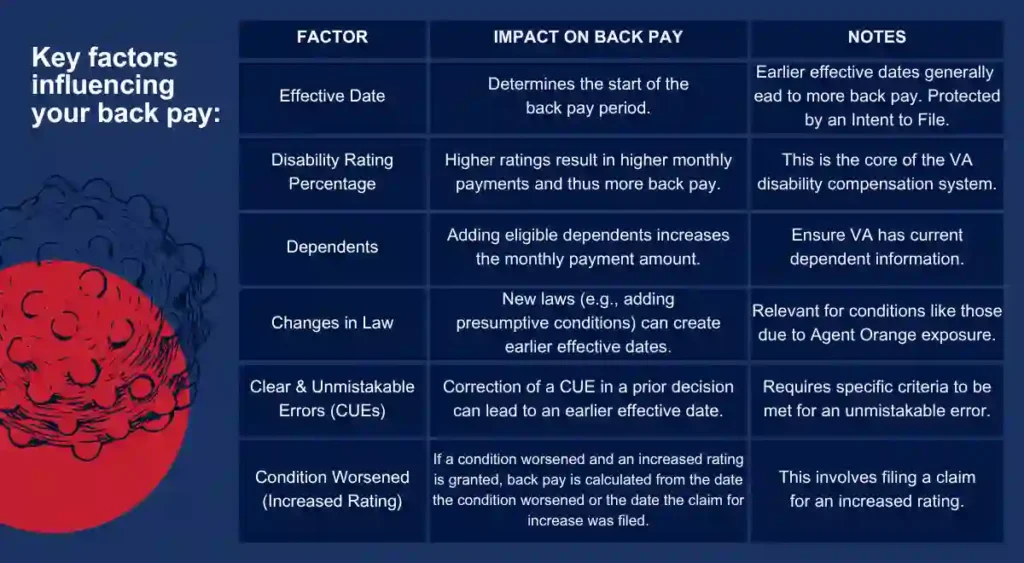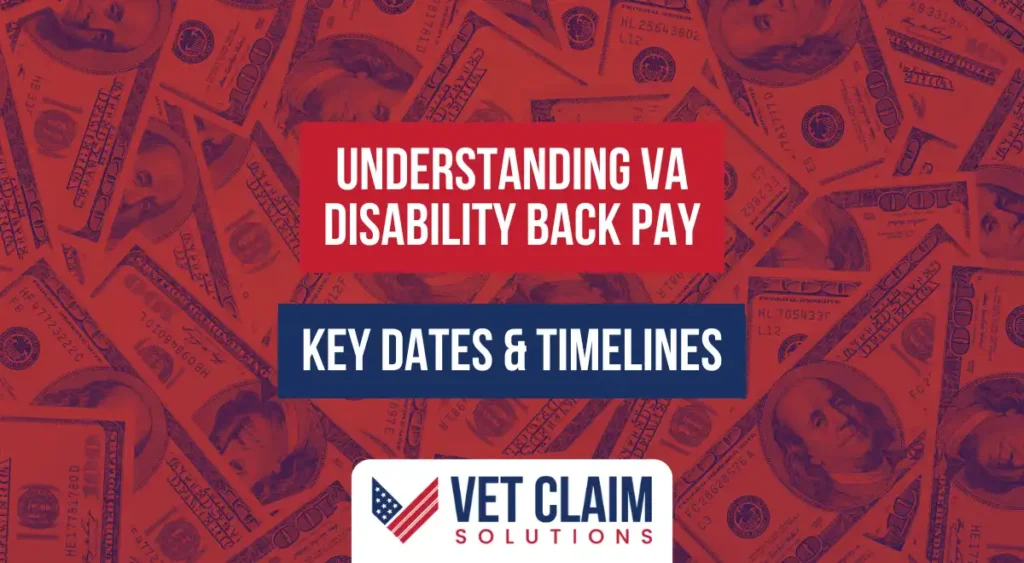Waiting for your VA disability benefits can feel like a long time. You’ve served your country, faced challenges, and now you’re handling the claims process. It’s natural to wonder about the money you’re owed while you wait. That’s where understanding VA disability back pay details, how retroactive pay works, effective dates, and timelines becomes so important. Many veterans find this part of the process confusing, but it doesn’t have to be. This guide will help you grasp all the essential aspects of your potential back pay. Grasping these details is a big part of making sure you receive all entitled compensation.
What Exactly is VA Disability Back Pay?
Think of VA disability back pay as the money the VA owes you for a past period. This disability compensation covers the time from your official effective date up to the date your disability claim gets approved. The VA system isn’t instant; it takes time to review your medical evidence and make a decision, so this back payment covers that gap.
It’s important to know this isn’t the same as your regular monthly disability benefits. Back pay is a one-time, lump-sum payment for that past period of entitlement. Your regular monthly compensation will start after your va claim is approved and processed, usually deposited into your bank account.
This retroactive pay is a crucial component of your overall disability benefits. It acknowledges the time it took to process your claim and establish service connection. For many veterans, this lump sum can provide significant financial relief, helping to cover expenses accumulated while waiting for a decision.

Cracking the Code: Your VA Effective Date
Your effective date is critically important for calculating VA disability back pay. This date essentially kicks off when you’re eligible for benefits. The
VA has specific rules for setting this date for your veteran’s claim.
Generally, it’s the date the VA receives your claim or, even better, the date they receive your “Intent to File” form. We’ll discuss the “Intent to File” more thoroughly shortly. Understanding this date is fundamental because it directly impacts the amount of retroactive pay you may receive.
There are some situations where the effective date might be different. For example, if you file your initial VA claim within one year of leaving active service, your effective date could be the day after your military discharge. This special rule acknowledges the transition period for newly separated veterans.
Sometimes, changes in laws, such as the creation of new presumptive conditions for veterans exposed to certain toxins, can also shift this date for a previously denied claim. Additionally, if a Clear and Unmistakable Error (an unmistakable error) is found in a prior VA decision, the effective date could be corrected to an earlier date, potentially resulting in substantial back pay. It’s a detail you really want to pay attention to in your decision letter, as it dictates when your entitlement arose.
The Power of an Intent to File
Okay, let’s talk about an “Intent to File” or ITF. This is a simple form (VA Form 21-0966) you can submit to the VA, even before you have all your paperwork and medical records ready. Think of it like raising your hand and saying, “Hey VA, I plan to file a claim soon.”
Submitting an ITF can lock in an earlier effective date for your disability claim. As long as you submit your complete claim within one year of your ITF, the VA can use that ITF date as your original effective date. This action by a veteran who files could mean significantly more retroactive pay. Information on how to submit an Intent to File is available on the VA’s official website or through a veterans service organization.
Using an ITF gives you valuable time to gather all necessary medical evidence and supporting documents without losing potential benefits. It’s a strategic first step for any veteran considering filing a VA disability claim. This is especially helpful for complex cases where compiling evidence might take longer.

How VA Retroactive Pay is Calculated
The math for retroactive pay, or back pay, might seem tricky at first. But the basic idea is straightforward. The VA looks at your monthly disability payment amount, which is based on your assigned disability rating.
They multiply that monthly compensation amount by the number of months between your effective date and your claim approval date. So, a higher disability rating generally means a higher monthly payment and, potentially, more back pay when your claim approved status is finally reached. The VA continues to process payments based on these established rates.
However, there’s a VA quirk often referred to as “VA math.” The VA pays benefits for the preceding month; for instance, the payment you receive on July 1st is for the month of June. Also, the VA generally doesn’t pay for partial months of entitlement for back pay purposes if the effective date is not the first of the month. If your effective date isn’t the first of the month, your back pay typically starts from the first day of the following month. For example, if your effective date is January 15th, your pay starts accruing from February 1st for back pay calculation.
Your decision letter from the VA should outline this clearly. It will state your disability rating, your monthly payment amount, and your effective date. This information helps you understand how they figured out your retroactive pay for your disability benefits.
Understanding VA Disability Back Pay Details how retroactive pay works effective dates and timelines.
Now, let’s bring all these pieces together. Knowing the ins and outs here really empowers you as a veteran. When you understand these details, you can feel more confident about what to expect from the VA regarding your disability claims.
Factors That Shape Your Back Pay Amount
Several things can change how much back pay you receive. Your disability rating percentage is a major one. A 10% rating gets a certain amount of monthly compensation, while a 70% rating gets much more, so a higher rating means more back pay, assuming the same time frame for your va claim.
If your disability rating qualifies you for additional compensation for dependents, such as a spouse, children, or dependent parents, this also increases your monthly amount. That, in turn, boosts your potential back pay. It’s crucial to inform the VA about any changes in your dependent status promptly.
The specific effective date assigned by the VA is crucial. Even a month’s difference in the effective date can significantly change the final sum. Also, if your veteran’s condition worsened while your claim was pending, leading to an increased rating, this could impact the calculation, potentially resulting in tiered back pay amounts for different periods.
Here’s a table summarizing key factors influencing your back pay:

The Waiting Game: Timelines for VA Claims and Back Pay
So, how long does all this take? That’s a question every veteran asks when dealing with VA disability claims. Unfortunately, there’s no one-size-fits-all answer, as VA claim processing times can vary a lot. The VA provides some average processing times on their website, but your specific case could be shorter or longer due to various factors affecting the pay timeline.
Several things can slow down your claim. If the VA needs more information or additional medical evidence, that adds time to the overall processing times. Very complex cases, like those with multiple conditions or those requiring specialized medical opinions, often take longer to adjudicate. If you need to attend compensation and pension (C&P) exams, scheduling those can also add to the timeline for your VA disability claim.
Once your claim is finally approved, the back pay is usually issued as a lump sum. This is typically sent out separately from your first regular monthly disability payment. Your first regular payment often arrives on the first of the month after your claim decision month, and it will reflect your new disability rating and monthly compensation amount. Delays occur, so monitoring your claim status is important.
Seeing It in Action: Common Back Pay Scenarios
Let’s look at a few examples. This can help make the VA disability back pay process clearer. Keep in mind these are simplified illustrations of how retroactive pay works.
Example 1: An Initial Disability Claim
Imagine Veteran Mike submitted an Intent to File for his initial VA claim on March 1, 2023. He then gathered his documents and submitted his full disability claim for a knee condition on December 15, 2023. The VA approved Mike’s claim on July 10, 2024, establishing service connection.
They gave him a 30% disability rating. Let’s say a 30% rating for a single veteran at that time is $500 per month (this is a hypothetical number for easy math). Because Mike filed an ITF, his effective date is March 1, 2023. His back pay would cover the period from April 1, 2023 (the first full month after the effective date) up to June 30, 2024 (the month before his first regular payment in August). That’s 15 full months, so his retroactive pay would be $500 x 15 months = $7,500. The veteran receives this lump sum payment.
Example 2: Claim for an Increased Rating
Veteran Sarah already has a 20% disability rating for tinnitus. She later files for an increased rating on June 5, 2023, because her condition worsened. On January 20, 2024, the VA approves her increase to 40%. Let’s say the 20% rate was $300 and the 40% rate is $700 (again, hypothetical amounts for monthly compensation).
Her effective date for the increase is typically the date she filed the claim for increase, June 5, 2023, or if medical evidence proves the condition worsened prior to that date, an earlier date might be assigned. The back pay will be the difference between the new and old rates. So, $700 – $300 = $400 per month. Her back pay period would start July 1, 2023, and go through December 31, 2023. That’s 6 months, so Sarah’s back pay for the increased rating would be $400 x 6 months = $2,400.
Example 3: Appeals and Their Impact on Back Pay
Veterans’ appeals can definitely affect back pay. Let’s say Veteran David filed an original claim in 2022 that resulted in a denied claim. He appealed the decision through the appropriate channels. After a lengthy process, his appeal is successful in 2024.
If David kept his appeal “alive” by meeting all deadlines and maintaining continuous pursuit, his effective date could potentially go all the way back to his original claim date in 2022. This could result in a significant amount of back pay. Maintaining continuous pursuit of a claim through the appeals system is important here; if there are gaps where deadlines are missed, it can change the potential original effective date.

Example 4: Presumptive Conditions and Back Pay
Consider a Vietnam veteran diagnosed with ischemic heart disease, a known Agent Orange presumptive condition. If this veteran files a claim and Agent Orange exposure is conceded, the effective date rules for presumptive conditions apply. For instance, if a law changes to include ischemic heart disease as a presumptive condition linked to Agent Orange, and the veteran files within one year of that law change, the effective date could be the date the law changed.
If the veteran diagnosed had filed previously and was denied before the condition became presumptive, filing a supplemental claim with new evidence (like the change in law) could reopen the case. The back pay, in this scenario, could be substantial, potentially going back to the date the entitlement arose based on the new presumption or an earlier filed claim, depending on the specifics. This highlights how presumptive conditions can significantly impact back pay for veterans exposed to toxins like Agent Orange.
What If My Back Pay Calculation Seems Off?
It happens. Sometimes veterans look at their back pay amount and think something isn’t right or that VA errors occurred. The first thing to do is carefully review your VA decision letter. This letter should explain the effective date they used and how they calculated your payments. It should detail the monthly compensation rates applied.
There can be common reasons for a difference. Maybe the VA has an old address, leading to delays in communication, or perhaps they don’t have your correct dependent information. Sometimes, it’s a simple miscalculation of dates or incorrect banking information delaying the deposit into your bank account. If you believe there’s an error, especially with the effective date determination, you have options to resolve issues.
Gather all your documents, like your decision letter, copies of what you submitted to the VA, and any relevant medical records. You can contact the VA by phone or use their online “Ask VA” tool. Explain your concerns clearly and provide specific reasons why you believe the calculation or effective date is incorrect. If you still disagree after speaking with them, you might consider filing for a Higher-Level Review using the appropriate VA form, or a Supplemental Claim if you have new and relevant evidence.
Smart Steps to Potentially Maximize Your Back Pay
While much of the process is up to the VA, you can take steps. These actions can help protect your earliest possible effective date for your disability benefits. They might also help speed up your va disability claim processing.
The most important tip? File an “Intent to File” (VA Form 21-0966) as soon as you think you might have a claim. You can do this online via the VA website, by mail. This simple step can preserve an earlier effective date, which translates directly to potential retroactive pay when your VA disability compensation is approved.
When you are ready to submit your full claim, consider filing a Fully Developed Claim (FDC) if possible. This means you submit all relevant records and medical evidence at the same time you file your claim; essentially, the evidence proves your claim. The VA states that FDCs can often be processed more quickly than standard claims, potentially reducing delays. Always respond quickly if the VA asks you for more information or schedules you for C&P exams related to your mental health or physical conditions. Delays on your part can unfortunately mean delays in your decision and your pay.
Keep meticulous copies of every single document you send to the VA, and note when claims filed. It’s also wise to send important documents using a method that gives you proof of delivery.

Conclusion
Handling the VA system can feel challenging, but it’s manageable when you break it down into understandable parts. Understanding VA Disability Back Pay Details how retroactive pay works effective dates and timelines is a crucial piece of this puzzle. Knowing about effective dates, the importance of an Intent to File, how service connection is established, and how back pay is generally calculated can make a real difference in your experience with your disability claim.
While the pay timeline can vary based on claim status and processing times, being proactive and informed helps you advocate for yourself effectively. This applies whether you are filing an initial VA claim, a claim for an increased rating due to a condition worsened, or even a supplemental claim with new evidence. Remember, this disability compensation is for the sacrifices you’ve made and the impact your active service has had on your health.
Take the time to understand your rights and the VA disability claims process. Whether you’re a Vietnam veteran dealing with Agent Orange exposure and conditions like ischemic heart disease or a veteran with other service-connected disabilities, the principles of back pay remain important. Knowledge empowers you to ensure you receive the full VA disability benefits you are entitled to, including all appropriate retroactive pay.


